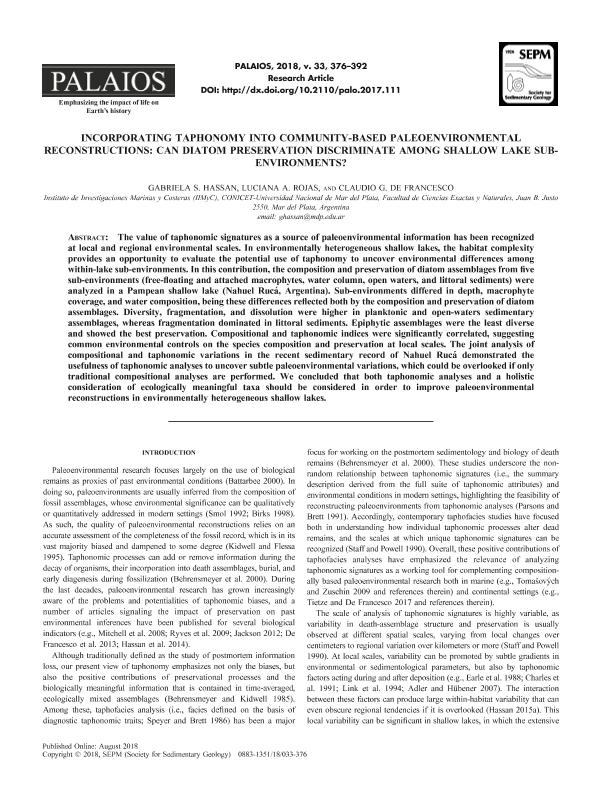Mostrar el registro sencillo del ítem
dc.contributor.author
Hassan, Gabriela Susana

dc.contributor.author
Paredes Rojas, Yesica Luciana

dc.contributor.author
de Francesco, Claudio German

dc.date.available
2019-11-05T19:40:17Z
dc.date.issued
2018-08-21
dc.identifier.citation
Hassan, Gabriela Susana; Paredes Rojas, Yesica Luciana; de Francesco, Claudio German; Incorporating taphonomy into community-based paleoenvironmental reconstructions: Can diatom preservation discriminate among shallow lake sub-environments?; Society for Sedimentary Geology; Palaios; 33; 8; 21-8-2018; 376-392
dc.identifier.issn
0883-1351
dc.identifier.uri
http://hdl.handle.net/11336/88080
dc.description.abstract
The value of taphonomic signatures as a source of paleoenvironmental information has been recognized at local and regional environmental scales. In environmentally heterogeneous shallow lakes, the habitat complexity provides an opportunity to evaluate the potential use of taphonomy to uncover environmental differences among within-lake sub-environments. In this contribution, the composition and preservation of diatom assemblages from five sub-environments (free-floating and attached macrophytes, water column, open waters, and littoral sediments) were analyzed in a Pampean shallow lake (Nahuel Rucá, Argentina). Sub-environments differed in depth, macrophyte coverage, and water composition, being these differences reflected both by the composition and preservation of diatom assemblages. Diversity, fragmentation, and dissolution were higher in planktonic and open-waters sedimentary assemblages, whereas fragmentation dominated in littoral sediments. Epiphytic assemblages were the least diverse and showed the best preservation. Compositional and taphonomic indices were significantly correlated, suggesting common environmental controls on the species composition and preservation at local scales. The joint analysis of compositional and taphonomic variations in the recent sedimentary record of Nahuel Rucá demonstrated the usefulness of taphonomic analyses to uncover subtle paleoenvironmental variations, which could be overlooked if only traditional compositional analyses are performed. We concluded that both taphonomic analyses and a holistic consideration of ecologically meaningful taxa should be considered in order to improve paleoenvironmental reconstructions in environmentally heterogeneous shallow lakes.
dc.format
application/pdf
dc.language.iso
eng
dc.publisher
Society for Sedimentary Geology

dc.rights
info:eu-repo/semantics/openAccess
dc.rights.uri
https://creativecommons.org/licenses/by-nc-sa/2.5/ar/
dc.subject
TAPHONOMY
dc.subject
DIATOMS
dc.subject
SHALLOW LAKES
dc.subject
PAMPA PLAIN
dc.subject.classification
Paleontología

dc.subject.classification
Ciencias de la Tierra y relacionadas con el Medio Ambiente

dc.subject.classification
CIENCIAS NATURALES Y EXACTAS

dc.title
Incorporating taphonomy into community-based paleoenvironmental reconstructions: Can diatom preservation discriminate among shallow lake sub-environments?
dc.type
info:eu-repo/semantics/article
dc.type
info:ar-repo/semantics/artículo
dc.type
info:eu-repo/semantics/publishedVersion
dc.date.updated
2019-10-24T19:38:30Z
dc.identifier.eissn
1938-5323
dc.journal.volume
33
dc.journal.number
8
dc.journal.pagination
376-392
dc.journal.pais
Estados Unidos

dc.journal.ciudad
Lawrence
dc.description.fil
Fil: Hassan, Gabriela Susana. Consejo Nacional de Investigaciones Científicas y Técnicas. Centro Científico Tecnológico Conicet - Mar del Plata. Instituto de Investigaciones Marinas y Costeras. Universidad Nacional de Mar del Plata. Facultad de Ciencias Exactas y Naturales. Instituto de Investigaciones Marinas y Costeras; Argentina
dc.description.fil
Fil: Paredes Rojas, Yesica Luciana. Universidad Nacional de Mar del Plata; Argentina
dc.description.fil
Fil: de Francesco, Claudio German. Consejo Nacional de Investigaciones Científicas y Técnicas. Centro Científico Tecnológico Conicet - Mar del Plata. Instituto de Investigaciones Marinas y Costeras. Universidad Nacional de Mar del Plata. Facultad de Ciencias Exactas y Naturales. Instituto de Investigaciones Marinas y Costeras; Argentina
dc.journal.title
Palaios

dc.relation.alternativeid
info:eu-repo/semantics/altIdentifier/doi/http://dx.doi.org/10.2110/palo.2017.111
dc.relation.alternativeid
info:eu-repo/semantics/altIdentifier/url/https://pubs.geoscienceworld.org/sepm/palaios/article-abstract/33/8/376/546070
Archivos asociados
